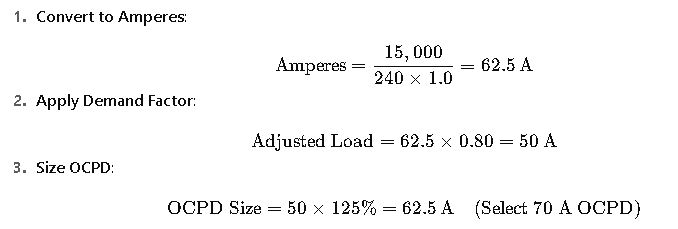Proper panelboard sizing ensures electrical systems operate safely, efficiently, and comply with NEC regulations. Engineers calculate loads, select devices, and apply demand factors accurately.
Accurate sizing prevents overloads, optimizes conductor selection, and ensures reliable power distribution in residential, commercial, and industrial installations.
Panelboard Sizing Calculator – NEC
What loads go where?
Heating vs cooling?
100%-rated breakers?
Panelboard Sizing Fundamentals
1. Load Calculation
The first step in panelboard sizing is determining the total connected load. This involves summing the wattage of all connected equipment and converting it to amperes using the formula:
For single-phase systems, the formula simplifies to:
2. Demand Factors
The NEC allows for the application of demand factors to reduce the calculated load, acknowledging that not all equipment operates simultaneously at full capacity. These factors are detailed in NEC Article 220.
3. Continuous and Non-Continuous Loads
- Continuous Load: A load expected to operate for three hours or more.
- Non-Continuous Load: A load expected to operate for less than three hours.
The NEC requires that overcurrent protection devices be sized to handle 100% of the non-continuous load plus 125% of the continuous load.
4. Overcurrent Protection Device (OCPD) Sizing
The OCPD must be selected based on the total load, considering both continuous and non-continuous components. The general formula is:
5. Conductor Sizing
Conductors must be sized to handle the expected load without exceeding their ampacity. The NEC provides guidelines for conductor sizing based on temperature ratings and load types.
Common Panelboard Sizing Values
| Load Type | Typical Value | NEC Reference |
|---|---|---|
| Residential Load | 100-200 A | NEC 220.82 |
| Commercial Load | 200-400 A | NEC 220.83 |
| Industrial Load | 400-1200 A | NEC 220.84 |
| Continuous Load | ≥3 hours | NEC 100 |
| Non-Continuous Load | <3 hours | NEC 100 |
| Demand Factor | 0.75 – 0.80 | NEC 220.82 |
| OCPD Sizing | 125% Continuous | NEC 240.4 |
| Conductor Sizing | 125% Continuous | NEC 310.15(B)(16) |
Real-World Examples
Example 1: Residential Panelboard Sizing
- Total Connected Load: 15,000 W
- Voltage: 240 V
- Power Factor: 1.0
- Continuous Load: 3,000 W
Calculations:

Example 2: Industrial Panelboard Sizing
- Total Connected Load: 100,000 W
- Voltage: 480 V
- Power Factor: 0.9
- Continuous Load: 80,000 W
Calculations:

Additional Considerations
1. 120% Rule for Backfed Circuits
When integrating renewable energy sources like solar PV systems, the NEC stipulates that the sum of the ampere ratings of overcurrent devices supplying power to a busbar or conductor should not exceed 120% of the busbar’s rating.
2. Motor Loads
For motor loads, the NEC requires sizing based on the full-load amperes (FLA) of the motor, adding 125% of the largest motor’s FLA, and 100% of the non-continuous non-motor load.
3. Panelboard Location and Accessibility
NEC Article 110.26 mandates that electrical panels be installed in readily accessible locations with sufficient working space.
Conclusion
Proper panelboard sizing is essential for the safe and efficient operation of electrical systems. By adhering to NEC guidelines and considering factors like load types, demand factors, and overcurrent protection, engineers can design systems that meet both performance and safety standards.
For further information and tools, consider exploring the following resources:
- Mike Holt’s Electrical Toolbox App
- Electrical Technology – NEC Code Requirements for Electrical Panels
- Electrical Feeder Calculation – Construction Monkey
FAQ – Panelboard Sizing Calculator – NEC
1. What is a panelboard?
A panelboard is an electrical device that distributes power to multiple circuits safely.
2. Why is proper panelboard sizing important?
Correct sizing ensures safety, prevents overloads, and complies with NEC regulations.
3. What factors influence panelboard sizing?
Factors include total load, continuous and non-continuous loads, demand factors, and voltage.
4. Can demand factors reduce panelboard size?
Yes, demand factors allow engineers to account for simultaneous load usage, reducing overall sizing.
5. What is the difference between continuous and non-continuous loads?
Continuous loads run for three or more hours; non-continuous loads run for less than three hours.
6. How does NEC affect panelboard design?
NEC provides mandatory rules for overcurrent protection, conductor sizing, and panel accessibility.
7. Are there standard panelboard sizes?
Yes, common residential panels range from 100-200 A, commercial from 200-400 A, and industrial from 400-1200 A.
8. What is the 120% rule?
It limits backfed circuits, ensuring overcurrent devices do not exceed 120% of the busbar rating.
9. How should motor loads be handled?
Motor loads require special sizing, considering full-load amperes and NEC adjustment factors.
10. Where should panelboards be installed?
Panels must be accessible, with sufficient working space as mandated by NEC Article 110.26.
11. Can panelboards handle renewable energy sources?
Yes, but designers must follow NEC rules for PV systems and backfed circuits.
12. How often should panelboards be inspected?
Panels should be regularly inspected for overloads, damage, or code compliance issues.
13. What materials are used for panelboard construction?
Common materials include steel, aluminum, and sometimes fire-resistant composites.
14. Are panelboards different for residential vs. commercial?
Yes, residential panels are smaller and simpler, while commercial/industrial panels handle higher loads and complexity.
15. How do temperature ratings affect panelboard sizing?
Conductors and breakers must account for ambient temperature to maintain safety and performance.


